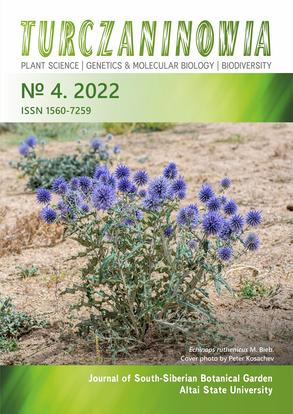On two species of Dracocephalum L. (Lamiaceae)
Abstract
A composition of taxa included in Dracocephalum imberbe Bunge s. l. is discussed. Species rank of D. laniflorum Rupr. is reinstated based on the following characters: underground part is represented by a system of branching rhizomes, bracts absent, calyx 12–14 mm long, with triangular or narrowly triangular, pointless teeth, the middle tooth of the upper lip up to 1.5 times wider than the lateral ones and plant being nearly scentless. In contrast, in D. imberbeunderground part is represented by the taproot and developed branches of the caudex, bracts present, with well-developed non-rigid points, calyx 15–18 mm long, with lanceolate or narrowly triangular pointed (though not rigid) teeth, the middle tooth of the upper lip 1.5–2 times wider than the lateral ones, the presence of a smell that persists in herbarium specimens. Dracocephalum laniflorum is firstly reported for flora of Kazakhstan (Almaty Region) and China(Xinjiang Uygur Autonomous Region) based on the study of herbarium materials stored in AA and LE, as well as scanned herbarium specimens stored in MW, HNWP and PE, which were available through the Moscow Digital Herbarium and Chinese Virtual Herbarium (CVH) systems.
Downloads
Metrics
References
Буданцев А. Л. Конспект рода Dracocephalum L. (Lamiaceae), 1 // Новости сист. высш. раст., 1989. Т. 26. С. 135–142.
Bunge A. 1835. Flora Altaica supplementum. Mém. Acad. Sci. Pétersb. 2: 523–608.
Chinese Virtual Herbarium (CVH) [2022]. Institute of Botany, Chinese Academy of Sciences Available. URL: https://www.cvh.ac.cn/ (Accessed 20 April 2022).
Heydari P., Yavari M., Adibi P., Asghari G., Ghanadian S.-M., Dida G. O., Khamesipour F. 2019. Medicinal Properties and Active Constituents of Dracocephalum kotschyi and Its Significance in Iran: A Systematic Review. Evidence-Based Complementary and Alternative Medicine: 1–14. Article ID 9465309. DOI: 10.1155/2019/9465309
Lazkov G. A. 2016. Labiatae (Family Labiatae Juss.) in flora of Kyrgyzstan. KH Bot. Monograph et Revisions Ser. 1: 1–384.
Li Xi-wen, Hedge I. C. 1994. Lamiaceae Lindley. In: Z.-Y. Wu, P. H. Raven, D.-Y. Hong (eds.). Flora of China. Vol. 17. Beijing: Science Press; St. Louis: Missouri Botanical Garden Press. Pp. 50–299.
Пешкова Г. A. Dracocephalum L. // Флора Сибири. Т. 11. Новосибирск: Изд-во «Наука», 1997. С. 170–185.
Ruprecht F. 1869. Sertum tianschanicum. Mém. Acad. Sci. Pétersb. ser. 7e. 14, 4: 33–74.
Seregin A. P. (ed.). 2019. Moscow Digital Herbarium: Electronic resource. Moscow: Moscow State University. URL: https://plant.depo.msu.ru/ (Accessed 20 April 2022).
Шишкин Б. К. Род Dracocephalum L. // Флора СССР. Т. 20. М.; Л.: Изд-во Академии наук СССР, 1954. С. 439–474.
Wang Wen-tsai. 1977. Dracocephalum Linn. In: Wu Cheng-yih, Li Xi-wen (eds.). Flora Reipublicae Popularis Sinicae. Vol. 65(2). Pp. 346–384.
Turczaninowia is a golden publisher, as we allow self-archiving, but most importantly we are fully transparent about your rights.
Authors may present and discuss their findings ahead of publication: at biological or scientific conferences, on preprint servers, in public databases, and in blogs, wikis, tweets, and other informal communication channels.
Turczaninowia allows authors to deposit manuscripts (currently under review or those for intended submission to Turczaninowia) in non-commercial, pre-print servers such as ArXiv.
Authors who publish with this journal agree to the following terms:
- Authors retain copyright and grant the journal right of first publication with the work simultaneously licensed under a Creative Commons Attribution License that allows others to share the work with an acknowledgement of the work's authorship and initial publication in this journal.
- Authors are able to enter into separate, additional contractual arrangements for the non-exclusive distribution of the journal's published version of the work (e.g., post it to an institutional repository or publish it in a book), with an acknowledgement of its initial publication in this journal.
- Authors are permitted and encouraged to post their work online (e.g., in institutional repositories or on their website) prior to and during the submission process, as it can lead to productive exchanges, as well as earlier and greater citation of published work (See The Effect of Open Access).





